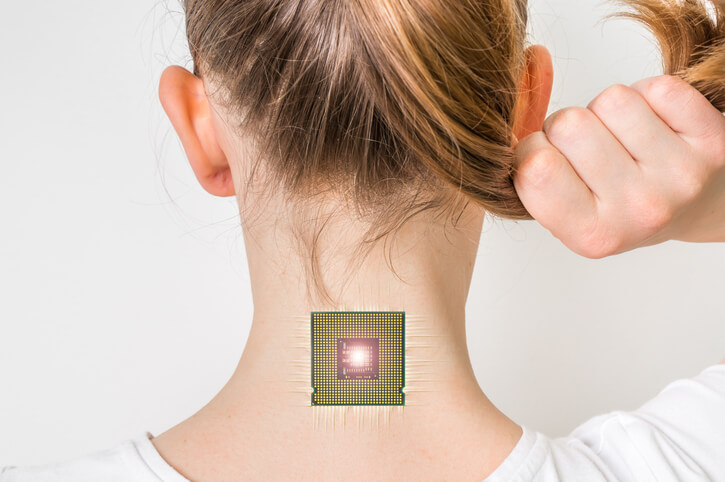Implantable wearables in healthcare
The implantable wearable devices are quite rare to read about comparing to the other digital solutions. They have not found their place in the mainstream digital health market. They are the implanted devices that are placed inside the body parts or under the skin for tracking the various diseases or the particular health condition. The implanted wearable is also referred to as embeddable technology for inserting directly into the body for the healing purpose.
These implantable wearables operate with the help of wireless communication technology and are battery powered. The new wireless charging technique is known as the ‘midfield wireless transfer’, helps the implanted device to get charge through the sensors. The generic applications of the wearable implants are birth control chips, smart tattoos, defibrillators, tiny healing chips, monitoring heart, dermally implanted sensors, etc.
The wearable and implantable devices are easily able to get the parameter of diseases and can help the patient in getting treated using the monitoring feature of the device. The Smart tattoos can help to monitor the heart rhythms in adults as well as premature babies. Using the smart tattoos, the patient can also get treated from sleeping disorders. The defibrillators are intended to manage the unusually fast heart rhythms by delivering electrical power to the heart.
The birth control chips are the latest invention to prevent pregnancy by wearing the implant inside the forearm.
The tiny healing chips are micro implants that are used for monitoring different organs of the body as well as for the healing of diseases or particular health condition.
These chips use the RFID (radio frequency identification) technology for successful implantation. The line between the virtual and reality is blurring with the growing market of the implantable wearables across the globe. The industry is providing opportunities for the qualified and technical positions in the healthcare industry along with the ease of treatment. The global medical sensor market is expected to grow at a CAGR of 8.5% from 2016 to 2022. Above all, the implantable medical wearable market is expected to reach USD 116,300 by 2022.
| Recommended for you | |
| Wearable robots helping people walk with exoskeletons | |
| Now, print your hand: 3D printed prosthetics | |
| Top 5 wearable devices for monitoring sleep |
Companies developing implantable wearable devices for healthcare
1. Proteus Digital Health: The startup provides better insights, treatment, and care with Proteus Discover, an FDA approved digital medicine. The product is comprised of indigestible sensors, a small wearable sensor patch and an application on the smartphone with a provider portal. The product offers easy monitoring of the patient’s health, optimized therapies, and improved outcomes. The Proteus Discover works when the patient activates it by taking medication with an indigestible sensor.
When the sensor reaches the stomach, it starts transmitting the signals to the patch worm. After it, the digital record is sent to the patient’s connected mobile device and to the Proteus Discover Cloud data (where the healthcare provider can get the accurate data information).
The sensor helps in treating and monitoring the cardiovascular diseases, infectious disease and performance and safety of the health.
2. Merck & Co.: The company has developed a birth control implant product called, Nexplanon that is 99% effective. It is a small, thin and flexible arm implant that helps with three years of continuous birth control. At the end of the third year, the implant is removed and is replaced by a new implant. For birth control, Nexplanon puts a low and steady dose of hormone into the bloodstream to stop the release of the egg inside the woman’s body. Until the woman has the implant inside her forearm, she is prevented from getting pregnant.
3. Endotronix: The company is advancing the treatment of heart failure with hemodynamic monitoring solutions to detect worsening heart failure than ever before. The Cordella Heart failure system is the successful product introduced by the company that acts as a pulmonary artery pressure sensor once it is implanted inside the artery.
The sensor is connected to the patient’s smartphone app and clinic portal for sharing the pulmonary heart pressure, blood circulation and pulse rate of the patient. Using the clinical portal, the doctor or medical experts can review the data and communicate with the patient in managing the health condition.
4. Boston Scientific: The startup has introduced a Spinal Cord Stimulator (SCS) systems for treating chronic pain inside the body. The SCS systems are a thin and small pulse generator implant that is placed inside the body that masks pain signals received from the brain.
Instead of the pain, the patient experience tingling or other sensation. The medical term for the sensation is called ‘Paresthesia’.
The specific sensor implant is used by the patients who are experiencing unbearable pain inside the body.
5. Axonics Modulation Technologies: The startup has raised USD 17.3 Million for successfully developing a small implant dedicated to urinary and faecal dysfunction. The so-called product, Sacral neuromodulation also known as Sacral nerve stimulation is inserted in the sacrum during a small surgery.
Recommended by the American Urology Association and European Association of Urology, the product is a safe treatment for people suffering from urinary and faecal disorders. The implant uses electrical pulses to stimulate the sacral nerves for modifying the activity and correcting the nerve messages received from the brain.
6. Mayo Clinic: The Mayo Clinic has introduced Implantable Cardioverter-defibrillators (ICDs) for reducing the risk of dying when the lower chambers of the heart go into a dangerous rhythm or stop beating. The implant device works as electrical energy for restoring a regular heartbeat during any shock or trauma.
During the therapy, the patient might feel being kicked in the chest and might knock off the feet. The pain only lasts for a second, and the device is ready to use. The sensor transmits electrical pulses to regulate the heartbeat for avoiding any failures. Patients who have already survived after a heart failure should use the implant device for healthy living.
Future of the wearable devices is implanted
The implantable wearable devices are constantly assisting the healthcare industry in improving the patient’s health and monitoring the condition. With the decreasing size of the hardware, the increase in the implant technology has been noticed over years. The wearable implantable is the next generation technology that might replace the wearable technology in the coming years.
The best thing about these implants is they permanently store the information and data in our body. In the coming years, we will get to acknowledge with different microchip implants, which will make our lives more secure and healthy.
The sensor implant, stimulation of energy, rechargeable battery and wireless technology have successfully enhanced the market growth of the implanted devices.
The implantable market device market was valued at USD $72,265 Million and is now expected to reach USD $ 116,300 Million by 2022, supported by a CAGR of 7.1- 8.5%. On the other hand, the security of the implantable devices is questionable. Will the increasing cyber crime prove dangerous for the implantable sensors or chips inside the human body? Along with the benefits of the implantable devices, few questions hampers the trust of the society on the wearable tech.
Image credit: www.istockphoto.com

















